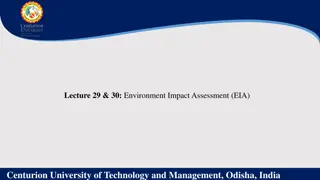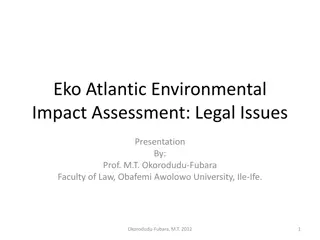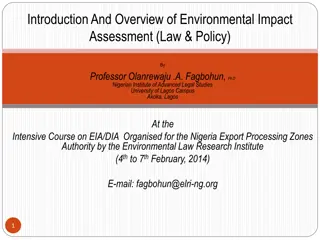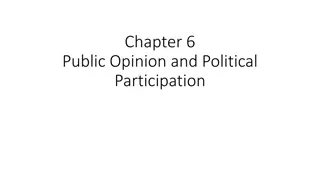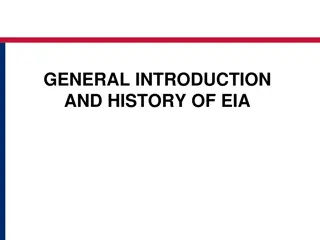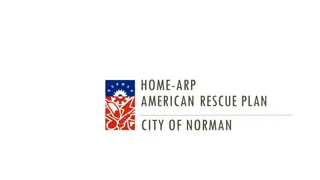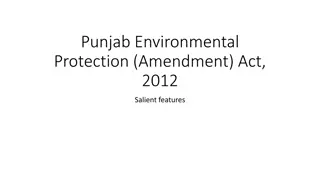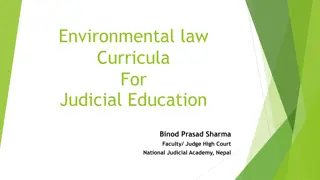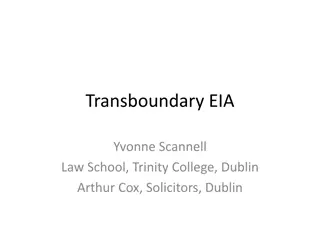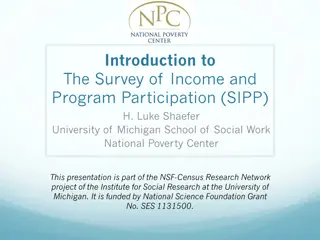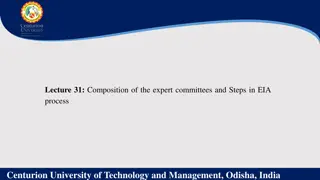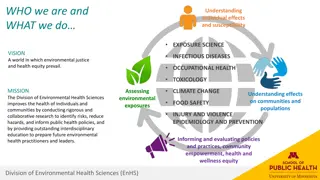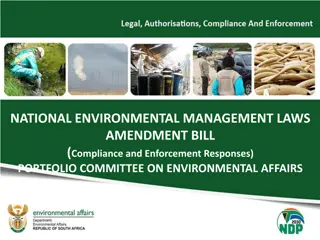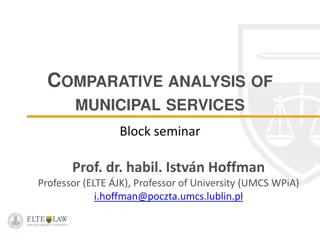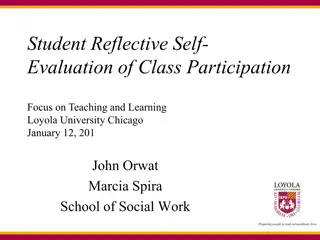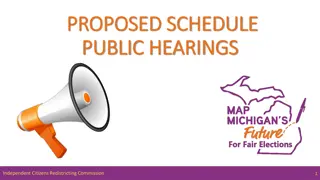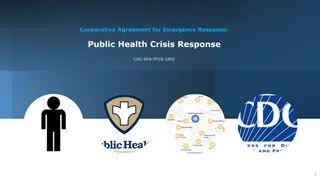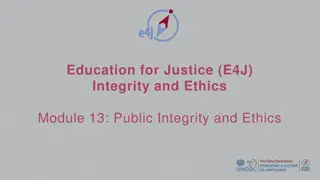Enhancing Environmental Impact Assessment Through Public Participation
Public involvement in the Environmental Impact Assessment (EIA) process is crucial for obtaining valuable insights, reducing conflicts, and improving decision-making transparency. This involvement aims to inform stakeholders, consider alternatives, and maximize benefits while addressing concerns. Key objectives include obtaining local knowledge, enhancing accountability, and fostering public confidence in the EIA process. Different levels of public involvement such as informing, consulting, participating, and negotiating play distinct roles in engaging stakeholders effectively.
Download Presentation

Please find below an Image/Link to download the presentation.
The content on the website is provided AS IS for your information and personal use only. It may not be sold, licensed, or shared on other websites without obtaining consent from the author. Download presentation by click this link. If you encounter any issues during the download, it is possible that the publisher has removed the file from their server.
E N D
Presentation Transcript
Public Participation Presented By: Saman Sana Lecturer Department of Environmental Sciences University of Veterinary and Animal Sciences
Introduction Public involvement is a fundamental principle of the EIA process. Timely, well planned and appropriately implemented public involvement programs will contribute to EIA studies and to the successful design, implementation, operation and management of proposals. Specifically public involvement is a valuable source of information on key impacts, potential mitigation measures and the identification and selection of alternatives. Nearly all EIA systems make provision for some type of public involvement. At a minimum, public involvement must provide an opportunity for those directly affected by a proposal to express their views regarding the proposal and its environmental and social impacts.
Purpose The purpose of public involvement is to: inform the stakeholders about the proposal and its likely effects; canvass their inputs, views and concerns; and take account of the information and views of the public in the EIAand decision making.
Key Objectives The key objectives of public involvement are to: obtain local and traditional knowledge that may be useful for decision-making; facilitate consideration of alternatives, mitigation measures and tradeoffs; ensure that important impacts are not overlooked and benefits are maximized; reduce conflict through the early identification of contentious issues; provide an opportunity for the public to influence project design in a positive manner (thereby creating a sense of ownership of the proposal); improve transparency and accountability of decision-making; and increase public confidence in the EIAprocess.
Levels and forms of public involvement Level Form of involvement Informing One way flow of information from the proponent to the public Two way flow of information between the proponent and the public with opportunities for the public to express views on the proposal Consulting Interactive exchange between the proponent and the public encompassing shared analysis and agenda setting and the development of understood and agreed positions on the proposal and its impacts Participating Face to face discussion between the proponent and key stakeholders to build consensus and reach a mutually acceptable resolution of issues, for example on a package of impact mitigation and compensation measures. Negotiating
In practice, public involvement in EIA largely corresponds to consultation. However, participation will be appropriate in many circumstances, for example, where a local population is displaced or relocated as a result of a project. A few countries also make provision for mediation or negotiation facilitated by a neutral third party. In principle, these approaches to public involvement in EIA are distinctive and relatively separate. However, they may be used in combination; for example, consultation and participation can be appropriate at different stages of the same EIAprocess.
Stakeholders Involved The range of stakeholders involved in an EIA typically includes: the people individuals, groups and communities who are affected by the proposal; the proponent and other project beneficiaries; government agencies; NGOs and interest groups; and others, such as donors, the private sector, academics etc.
Local People Individuals or groups in the affected community will want to know what is proposed; what the likely impacts are; and how their concerns will be understood and taken into account. They will want assurances that their views will be carefully listened to and considered on their merits. They will want proponents to address their concerns They will also have knowledge of the local environment and community that can be tapped and incorporated into the baseline data.
Proponents Understandably, proponents will wish to shape the proposal to give it the best chance of success. Often, this involves trying to create public understanding and acceptance of the proposal through the provision of basic information. More creatively, project design can be improved through using public inputs on alternatives and mitigation and understanding local knowledge and values.
Government agencies The government agencies involved in the EIA process will want to have their policy and regulatory responsibilities addressed in impact analysis and mitigation considered. For the competent authority, an effective public involvement program can mean the proposal may be less likely to become controversial in the later stages of the process. For the responsible EIA agency, the concern will be whether or not the public involvement process conforms to requirements and procedures.
NGOs/Interest groups Comments from NGOs can provide a useful policy perspective on a proposal; for example; the relationship of the proposal to sustainability objectives and strategy. Their views may also be helpful when there are difficulties with involving local people. However, this surrogate approach should be considered as exceptional; it cannot substitute for or replace views which should be solicited directly.
Other Interested Groups Other interested groups include those who are experts in particular fields and can make a significant contribution to the EIA study. The advice and knowledge of government agencies and the industry sector most directly concerned with the proposal should always be sought. However, in many cases, substantive information about the environmental setting and effects will come from outside resources.
The benefits of public participation for different groups The different benefits provided for key groups by effective public participation are described in the following table However, these benefits may not be always realized or acknowledged by participants Each of the above groups may perceive the benefits gained from public involvement in the EIA process through the lens of their own experience and interests
The benefits of effective participation for different groups The proponent The decision-maker Affected communities Raises the proponent s Achieves more awareness of the potential Provides an opportunity to raise informed and impacts of a proposal on concerns and influence the accountable decision the environment and the decision-making process making affected community Provides increased Provides an opportunity to gain Legitimises proposals and assurance that all a better understanding and ensures greater acceptance issues of legitimate knowledge about the and support concern have been environmental impacts and risks addressed that may arise
Demonstrates fairness and transparency, avoiding of decisions made behind closed doors Increases decision-making work, who makes decisions and on what basis awareness of processes how Improves public trust and confidence accusations being Empowers people, providing the knowledge that influence decision making and creating a greater sense of social responsibility Promotes relations proponent parties good the third they can Assists by obtaining local information/data with and Avoids costly delays later in the process resolving conflict early potentially Avoids potentially costly delays later in the process by resolving conflict early Ensures all relevant issues and concerns are dealt with prior to the decision by
Most EIA systems make some type of provision for public involvement. The legal and procedural requirements for this purpose vary. In developing countries, the EIA procedure established by the development banks will take precedence for projects carried out with their assistance. All of the major development banks consult the public during the EIA process carried out on their operations. Their specific requirements differ regarding timing and scope of consultation and type and amount of information disclosed.
Example: World bank operational policy (4.01) specifies that consultation with affected communities is the key to the identification of impacts and the design of the mitigation measures. It strongly recommends consultation with affected groups and NGOs during at least the scoping and EIA review stage. In projects with major social components, such as those requiring voluntary resettlement or affecting indigenous peoples, the process should participation in the EIAand project development process. involve active public
The provision made for public involvement should be consistent with principles established by International Law and Policy The most comprehensive treaty in this regard is the Aarhus Convention, although this applies only to UNECE countries and only entered into force in 2001 (by ratification by a sufficient number of signatory countries) However, it is likely to set important new precedents for standards of public involvement.
Reference to public participation in international law and the Aarhus Convention: Declaration on environment and development (1992) which states that each individual shall have the opportunity to participate in decision making processes, facilitated by the widespread availability of information Lefkowtiz (2000). Principle 10 of the Rio UNECEConvention on Environmental Impact Assessment in a Transboundary Context (Espoo, 1991) which provides for the participation of the public in the areas likely to be affected by a proposal (article 2, paras 2and 6, and article 4, para 2) Justice in International Environmental Matters (Aarhus) (1998) is the most comprehensive legal instrument relating to public involvement. Source: adapted from Stec and Casey- UNECE Convention on Access to Information, Public Participation in Decision Making And Access to The Framework Convention on Climate Change (1992), which requires parties to promote and facilitate public participation in addressing climate change and its effects and developing adequate responses (article 6(a) (iii))
Principles of Public Involvement The process should be: Inclusive: cover all stakeholders Open and transparent: steps and activities are understood Relevant: focused on the issues that matters Fair: conducted impartially and without bias toward any stakeholder Responsive: to stakeholder requirements and inputs Credible: builds confidence and trust
Public Involvement in Key Stages of EIA Screening: determining the need for, and level, of the EIA process Scoping: identifying the key issues and alternatives to be considered Impact analysis: identifying the significant impacts and mitigation measures Review: commenting on/responding to the EIA report Implementation and reporting: checking EIA follow up
Public involvement program Developing a public involvement program typically involves: Determining its scope Identifying interested and affected public Selecting appropriate techniques Considering the relationship to decision making Providing feedback to stakeholders Undertaking the analysis of stakeholder inputs Keeping to budget and timelines Confidentiality
Factors Affecting the Effectiveness of Public Involvement Poverty Remote and rural settings Illiteracy Cultural/local values Language Legal systems override traditional ones Dominance of interest groups Proponent confidentiality
Principles for Successful Application of Public Involvement Techniques Provide the right information Allow sufficient time to review and respond Provide appropriate opportunities/ means for stakeholder involvement Respond to issues and concerns raised Feedback the results of public input Chose venues and time of events to suit stakeholders
Principles for minimizing conflict Involve all stakeholders Establish communication channels Describe the proposal and its objectives Listen to the concerns and interests of affected people Treat people fairly and impartially Be empathetic and flexible Mitigate impacts and compensate for loss and damage Acknowledge concerns and provide feed back
Common reasons given for avoiding public involvement It s too early It will take too long and will cost too much It will stir up opposition We will only hear from articulates We ll raise expectations People won t understand
Conclusion Public involvement can be a time-consuming and costly exercise however if properly planned and implemented can benefit and speed up the process. This issue can be best addressed by sound planning. A proposal may be subject to delay and added expense if public consultation is non- existent or inadequate.
Group Activity Pg 103


